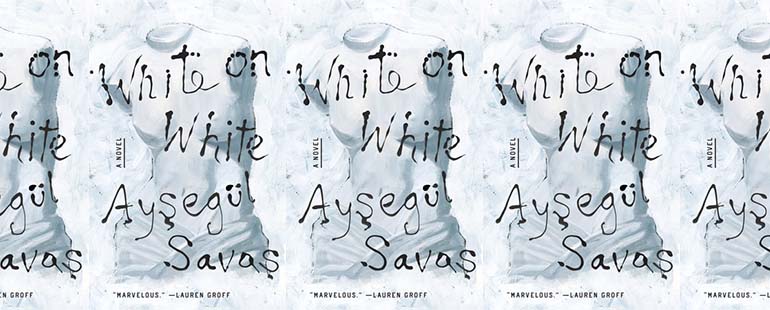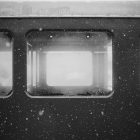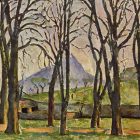Visual and Literary Representation in White on White

When the art historian and critic Leo Steinberg viewed the first one-man show of the American painter Jasper Johns in 1958—a collection of numbers, letters, US flags, and tri-colored targets painted in thick oil and encaustic—he was initially bored. “I was angry at the artist,” he wrote, “as if he had invited me to a meal only to serve something uneatable, like tow and paraffin.” But Steinberg eventually came around to Johns’s work and its disturbing inversion of the transcendental ambitions of painting, becoming one of its most important champions. “The pictures remained with me—worked on me,” he wrote. I was reminded of Steinberg’s response while reading Ayşegül Savas’s 2021 novel, White on White. I admit that my initial reaction to it echoed the feelings I held about abstract painting when I was introduced to it in college—like Steinberg, I was intrigued, though simultaneously disoriented and confused.
The calculated restraint of Savas’s prose and narrative worked on me. This restraint has been noted by other critics, including in a review on this site by Amber Ruth Paulen, who analyzes the novel’s take on what little we can really know about other humans. White on White also interrogates the form of the novel itself and its capacity for storytelling and representation. The book’s most basic details invite a comparison with the visual arts: the narrator is a PhD candidate writing a dissertation on medieval sculpture in an unspecified European city. The student rents an apartment from a painter, Agnes, whose name recalls the American abstract painter Agnes Martin. These loose connections to the visual are more than just passing references, and the novel converses with mid-century American painting more than jamb sculpture in church porticoes. The references lead us to an interrogation of the shared capacity of the formal tools of visual and literary representation.
The novel’s title might invoke the work of a number of mid-century American painters, including Johns, Martin, and Robert Rauschenberg. It perhaps most clearly aligns with the canvases of Robert Ryman, who painted almost exclusively with white paint from the late 1950s until his death in 2019. Ryman, however, did not consider his work to be monochromatic, nor did he really consider his paintings white. The terms risk implying a homogeneity of texture and uniformity of surface; instead, Ryman’s limited palate opens up an astonishing range of subtleties: light and dark; the shades of white in oil, acrylic, casein, and enamel; the changes in color when paint is applied with different brushes, with different pressures, with different techniques; the color of the support—paper, cotton, or steel—that collaborates with the surface paint in myriad ways; and the color of the environment—cast shadows and the light of the galleries in which the paintings are viewed. In this way, white provides a kind of experimental control that guides viewers to his paintings’ material complexity.
Every Ryman painting is derived from a discrete set of circumstances, options, and concerns. While many of his peers attended art school, often funded by the GI Bill, Ryman shunned formal education and began his self-training while working as a guard at the Museum of Modern Art in 1953. Rather than approaching his painterly practice as the pursuit of mastery, he approached it as a site of experimentation, a quest to find out “how the paint worked,” as he put it. Ryman aligned his practice with materials rather than representation or meaning. Each painting thus serves as a record of a particular moment with remarkable variety.
White on White is a story of someone else’s stories, as if Savas is experimenting with how stories work. Its structure unsettles what we know about its characters and their motivations. Charming and polished, Agnes begins to spend more time in the studio space above the apartment. As dissertation research gets underway, Agnes and the student fall into a routine of friendly, casual encounters, in which the painter describes her relationship to her children, her husband, her parents. The housemates gradually grow more comfortable around each other, and the student begins to expect Agnes’s presence. Yet it is clear that Agnes is presenting herself to the student, and indirectly to us. As Agnes’s successive monologues unfold, brief interjections by the narrator remind us that we are hearing Agnes’s story indirectly; we know her words and their meaning only as the student relays them. I began to wonder if Agnes or the narrator were lying, spinning a fictional world that would dramatically unravel later in the novel. I wondered whether the stories that Agnes’s monologues provide were the necessary build up to a later plot twist.
Like Ryman’s experiments in painting, White on White unfolds as a series of tests in what emerges from a set of unique and exquisitely described conditions. The student’s encounters with Agnes and her subsequent monologues read like a loosely connected string of experiments in representation; her digressions are set off by a particular set of conditions or a specific prompt by her companion. Some of her stories are painfully intimate. Agnes tells of her first sexual encounter with a professor when she attended art school, and the ongoing unraveling of her marriage to an art historian, Pascal. Agnes recalls that Jana, a nanny hired to look after their two children, was extraordinarily beautiful and agreed enthusiastically to have her portrait painted by Agnes, but the portrait could not capture her good looks. Rather, the finished painting betrayed a “frown of suspicion,” introducing a tension of betrayal. Agnes’s narration suggests a rivalry with Jana for the affections of her husband, Pascal, but nothing develops.
Like Ryman’s subtle marks and brushstrokes, Savas leads us to revel in the vividness of her prose and the tension of its unfolding. In between encounters with Agnes, the student searches for the meaning and symbolism of Gothic nude sculptures of the twelfth and thirteenth centuries. The student pursues this despite warnings from an academic adviser that there might not be much to investigate. The student works earnestly in cathedrals and archives, but no groundbreaking discoveries emerge. Both reader and narrator are ultimately left with an idea that is yet to be fulfilled. But the achievement of interpretive breakthrough seems insignificant in comparison to the process of research, the presence in reading rooms with stained-glass windows, the journeys to cathedrals in nearby towns, the empty time between when the library closes and when the narrator has dinner alone in a café. We easily inhabit their perspective, only realizing deep into the book that the name and gender of the student is never mentioned. Savas’s exquisite descriptions of the city in which the story takes place (the cathedrals in the city square, the kebab shop) are ultimately unspecific; despite the vividness of the text, the precise setting (perhaps Cologne? Or Rouen?) is never disclosed.
One afternoon, the student returns to the apartment and meets Agnes in her studio. The artist shows the student what she had been working on: a white painting in which its facture consists of subtle variations in textures, shades, and thickness. Agnes tells the student that she had hoped it would be the first of a series, but she doubted there was anything left to explore. “It may be nothing more than a gimmick,” she admits. Here, Savas captures some of the anxiety felt by artists and viewers alike when the more familiar tools of representation are eliminated. At issue is whether artistic expression is devalued by extreme restraint, whether such subtleties can have meaning or purpose. But despite Agnes’s painterly pursuits, Savas hardly portrays her as an artist of Ryman’s caliber. Rather, Agnes seems like an artist who has lost her way, thrown off course by maternal responsibilities and overshadowed by her husband’s academic career.
The novel begins with the student describing the light on the curtains, floorboards, and bedsheets in the apartment in the vivid detail we might expect from an expert in visual analysis. “Everything was marked with life,” the student announces. The apartment is sparse, an empty canvas filled with potential. But by the end of the novel, it seems like that potential has not been fulfilled. The exact same description of the apartment at the beginning of the novel resurfaces near the end. Here, the description feels more fraught with conflict and bubbling tension, changed by its context more than its innate form. The refrain comes immediately after a confrontation between Pascal and the student, as the marriage between Pascal and Agnes dissolves. Pascal stops by the apartment unexpectedly one evening to pick up a few items, including a small landscape painting that he once gave to Agnes. In his conversation with the student, Pascal provides a rather different portrayal of Agnes and their marriage than does Agnes. They have a tense confrontation about who really knows Agnes best. But the truth is that no one does.
The last scene of the novel is set in Agnes’s studio, as the student is wrapping up their research and preparing to return to their university. “The light had drained from the studio,” we read, marking a distinct change in our perception of the space and of Agnes. She is now described with “feverish eyes” and “the face of an animal.” On the last pages, Agnes reveals her painting to the student: a scene of people gathered around a table on a canvas taking up an entire wall. As Agnes tells stories of her parents and cousins, the narrator slowly realizes the disturbing tone of the painting. It seems to capture the likeness of those that appear in Agnes’s familial monologues, “with the twisted expressions of gargoyles.” Eventually, the narrator recognizes their own depiction in the scene. “I recognized the features—relentless and repeating—of my own face.” The student tells Agnes that the painting makes them uncomfortable, but nothing happens.
There is a history of literature in which characters are undone by the presence of a painting. Yasmina Reza’s 1994 play Art turns on an abstract, minimalist painting on which two friends project their personal insecurities and resentments. Oscar Wilde’s The Picture of Dorian Gray (1890) interrogates the boundary between representation and reality as a portrait drives its sitter to madness. In Nathaniel Hawthorne’s short story “The Prophetic Pictures” (1837), a pair of marriage portraits destroys the bright future of a young couple, leaving the reader to question whether the paintings determined their tragic fate. If White on White has a narrative arc at all, it is a similar decline from life to death. But the power of art to change fate, to drive a narrative toward a specific end, is also questioned. After all, Agnes tells the student that “it’s just a painting.” Its scene should have no impact on the course of their relationship. But it is nonetheless hard for the student to look away.
Like Ryman’s painting, Savas’s novel avoids providing a clear view onto another world or any transcendental meaning. Instead, both attempt to achieve a pure presence of form, in which the reader revels in the process of artistic production while being denied the traditional clues to meaning and interpretation. There is no narrative climax, no moment of revelation or shock. The tense pacing does not lead to any resolution or unraveling. The novel is less an act of purification than a challenge to the reader to accept art on its own terms as an achievement of presence. It frames each reading, each act of looking, as an act of faith.



